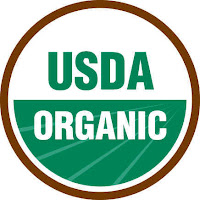It's doubtful that when Bobby created this recipe he would have even had the slightest inkling that some vegan chick in Minneapolis would be swearing with delight as she shoveled fork-fulls of the stuff into her mouth.

I don't know about you, but I think Bobby looks pretty "bitchin'" in this photo...He also looks like he just slipped a disk trying to pick up that skuer of cherry tomatoes.
As I've written before, one of my favorite things to do is rip off the food network stars by taking their recipes and making them into something I can eat. Every time I've done this, the recipes have turned out fantastic, and consequently, more healthy than their original version. (Bonus!)
This time, it was Bobby Flay's turn.
I was watching one of his "Throwdowns" that happened to be on fried chicken and potato salad. Naturally, the fried chicken wasn't what piqued my interest, it was the spuds.
Creamy and smoky with a southwestern flare, this potato salad will make you think twice about putting the old fashioned stuff on your plate ever again.


When I prepared this salad, I used a mixture of purple, red, and new potatoes...Aren't the colors beautiful?

The Vegenaise, lime juice, tomato and cilantro add a refreshing taste, while the mustard, chipotle peppers, jalapenos, garlic, onion, and scallions all add spice and flavor that is so bold it will make you come running back for more.
I did makes a few substitutions from the original recipe, like vegenaise for mayo ,and instead of the ancho chili powder I used one canned chipotle pepper and about 1 tsp of the adobo sauce. It gives it the smoky flavor and some nice heat that will surely give you a little kick in the pants. To prepare, I simply mashed the pepper into a paste and added to the mixture along with the adobo sauce. I also cut back on the garlic by one clove, and used a quarter of a red onion instead of the whole shebang...The flavors are definitely strong enough without it. Trust me on this, and you can always add more if you think I'm crazy. (The recipe below is altered to fit these changes)

Ahhhh...The sauce.
And here, ladies and gentlemen, is the finished product, garnished with a little cilantro fresh from the garden.

It's time to switch out that old-fashioned potato salad and opt for something a little more flavorful and bold. It's the perfect recipe to honor dad this weekend, so serve this one up for your Father's Day BBQ's and picnics!
Enjoy your weekend with family and friends, and, as always,
Eat Healthy, Stay Happy!
~jenni
Bitchin' Southwest Potato Salad
3 pounds new potatoes (I used a little over 2lbs)
Kosher salt
1 cup vegenaise
2 tablespoons Dijon mustard
2 tablespoons fresh lime juice
2 tablespoons ancho chili powder OR 1 canned chipotle pepper and 1 tsp of the adobo sauce.
Dash of cayenne pepper
Freshly ground black pepper
2 scallions, white and green parts, chopped
1 large ripe beefsteak tomato, seeded and chopped
1 jalapeno, finely diced
1/4 medium red onion, halved and thinly sliced
3 cloves garlic, finely chopped
1/3 cup freshly chopped cilantro leaves
Directions
Add the potatoes to a large pot and cover by 1-inch with cold water. Add 1 tablespoon of salt and bring to a boil over high heat. Cook until fork tender, 12 to 15 minutes and drain well. Let cool slightly then slice into 1/4-inch thick pieces and add to a large serving bowl.
Stir together the remaining ingredients in a medium bowl. Pour the mixture over the warm potatoes and mix gently until combined, mashing the potatoes slightly. Season again with salt and pepper, to taste, before serving.

































